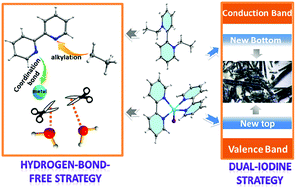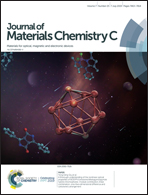Constructing moisture-stable hybrid lead iodine semiconductors based on hydrogen-bond-free and dual-iodine strategies†‡
Abstract
Hybrid perovskite-type light absorbers, notably based on methylammonium or formamidinium, have promising application in optoelectronics; however they are notorious for their characteristic low moisture stabilities and monotonous band gaps. Constructing new stability-enhanced hybrid lead iodine perovskites (HLIPs) with desired band gaps is imperative, but still a critical challenge. Herein, we demonstrate two effective strategies, which provide new ways to solve the above two issues. The “hydrogen-bond-free” strategy is aimed to enhance the stability of HLIPs by prohibiting organic components from forming strong hydrogen bonds with external water molecules. The “dual-iodine” strategy is used for the synthesis of stable HLIPs with reduced band gaps, which indicates that the I-coordinated metal complex can strongly reconstruct both the bottom of conduction bands (CBs) and the top of valence bands (VBs) of the inorganic lead iodine skeleton to reduce the band gaps. As a proof-of-concept application, ambient-stable HLIPs (1,1′-diethyl-[2,2′-bipyridine]-1,1′-diium)Pb3I8 (denoted as EtBpy-Pb3I8) and [Cu(2,2′-bipyridine)2I]2Pb2I6 (denoted as CuIBpy-Pb2I6) are synthesized, which can endure a relative humidity (RH) of 100% and sunlight irradiation for at least 60 days. Both EtBpy-Pb3I8 and CuIBpy-Pb2I6 show good photoconduction behavior with short rise and decay recovery time, and exhibit excellent repeatabilities of photocurrent. This work not only provides two new promising stability-enhanced lead-based semiconductors for light absorption application, but also opens new ways to enhance the stabilities and tune the band gaps of HLIPs.



 Please wait while we load your content...
Please wait while we load your content...